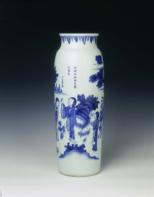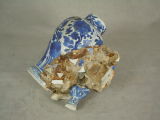Chinese Ceramics & the Early Modern World
2. Maritime Trade
The quantities of porcelain being transported by ship increased greatly after 1600, with the start of regular trading with European, particularly Dutch merchants. During the first decade of the seventeenth century the Vereenigde Oost-Indische Compagnie, or Dutch East India Company, established a series of permanent trading posts around Batavia (modern Jakarta) in Indonesia. The Dutch were to dominate the trade in Asian goods for the next two centuries. They used Batavia as their base, relying on Chinese junks to carry their cargoes along the coasts of present-day Vietnam and Malaysia to Java, from where they sent back a steady supply of Dutch ships laden with pepper, spices, and porcelains. The pieces trapped in an iron concretion included here were recovered from a ship that sunk in the South China Sea, en route to Batavia.
included here were recovered from a ship that sunk in the South China Sea, en route to Batavia.
During the twentieth century, a number of shipwrecks containing cargoes of Chinese porcelain were discovered throughout East and Southeast Asia. Shipwrecks provide archaeologists and historians with a unique opportunity to examine a ‘snapshot’ of export ceramics from a particular period, thus they provide valuable information about styles and designs. The durability of porcelain allows it to survive many centuries under water.



